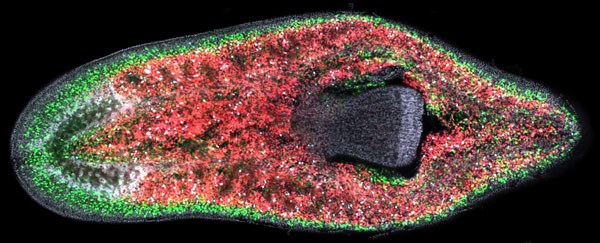What can worms teach us about how our body heals itself?
Summary:
We sat down with Dr. Bret Pearson to learn more about how worms respond to their wounds, which can give us insight on improving our healing and how tumours or tissues that have gone into healing hyper-drive may be formed.

What can worms teach us about how our body heals itself?
Freshwater planarians or flatworms have some of the best regenerative abilities of any animal; their genomes also share many similarities to humans. Understanding how they heal themselves may give us insight into how we recover from our injuries. Researchers have discovered a pathway that plays a key role in how the flatworm responds to injury. The research is published online in PLOS Genetics.
We sat down with the study’s senior author Dr. Bret Pearson, Senior Scientist in the Developmental & Stem Cell Biology Program at SickKids and Associate Professor in the Department of Molecular Genetics at the University of Toronto, to learn more about how worms respond to their wounds, which can give us insight on improving our healing and how tumours or tissues that have gone into healing hyper-drive may be formed.
What problem were you aiming to solve?
When animals encounter injuries, cells that remain must sense what has been lost, and respond accordingly. Often times, this requires a “wound response,” which eventually affects the proliferation and differentiation of tissue-specific stem cells. It is relatively unknown how cells can scale their responses to wounds, such as a paper cut vs. cutting off a fingertip. Our goal was to understand what controls the size of the wound response, ultimately leading to correct regeneration from injury.
What did you find?
Using freshwater planarians, we found that a pathway known to control growth and proliferation during development of animal embryos (the Hippo pathway), also has key roles in controlling the wound response during regeneration in adult planarians. When the function of the effector of the Hippo pathway, yorkie, is removed, planarians have a dysregulated wound response that ultimately causes failed regeneration. We’ve known that no response to injury causes failure of regeneration, but here we show that too much wound response causes a similar defect.
What is the significance of identifying this pathway?
We use model organisms to teach us about gene function. The novel findings that yorkie controls wound responses, that too much wound response causes failure of regeneration, and that tissue scaling during regeneration is inappropriate, makes us wonder whether similar mechanisms are at play in vertebrate injury responses. It is interesting to speculate that the Hippo pathway could be involved in the failure of humans to regenerate many of their tissues following injury.
Another aspect of this work is an explanation of how the Hippo pathway may influence cancers. Cancers tend to cause inappropriate injury responses, which may also be under the control of the Hippo pathway in humans.
What are the implications of your findings?
Our work has implications on regenerative medicine and cancer biology in humans, namely that the Hippo pathway must be carefully tested for a role in wound responses in mammals.
It is currently unknown how well our findings will apply to human biology. So like most basic research, any discovery must be tested in a vertebrate or mammalian model system. However, the Hippo pathway is well conserved in humans, so we believe this will be entirely possible.
This study was supported by the Ontario Institute for Cancer Research, The Hospital for Sick Children Restracomp PhD award program and SickKids Foundation.

